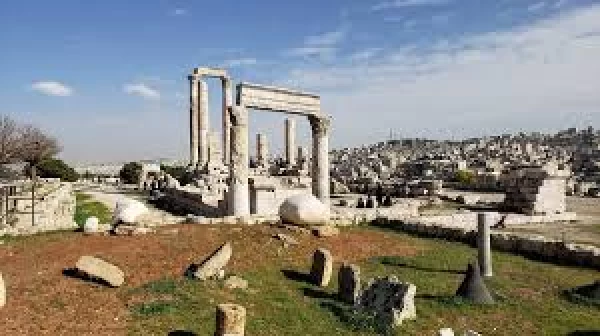
Roman Temple Of Hercules
The Roman Temple of Hercules is one of the oldest heritage and historical buildings in Amman, and remains to this day. It dates back to the second century AD, where it was built between 161 AD - 166 AD, under the supervision of the Roman Emperor Marcus Aurelius.
It is named the Temple of Hercules after the Roman god Hercules, whose mission was to protect and preserve the city. The temple was designed in typical Roman architectural form with the dimensions of 52m in length and 22m in width.
The temple is surrounded by a large portico lined with a sacral (sacred area). It was placed on a large stone platform, specially constructed to be visible from the lower city. Historians suggest that it was built over the ruins of an earlier shrine, which was devoted to the Milcom, the God of the Amorites.
This colossal statue is said to be 13 meters tall, making it at least as tall as the temple. You will likely be standing next to it, and now that it is so close to the temple ruins, you can take a photo of the remains of the statue with the ruins of the temple in the background.
Only the elbow and one hand remain in the ruins of the ancient sculpture representing the strength of the Roman hero, and the other remains of the temple are two complete columns and the remains of four more.
In the Temple of Hercules, sunrise and sunset reveal the entire temple bathed in slanting sunlight, with the shadows of the 9-metre-high columns cast to one side on the ground.
Latest Articles
Admin
Aswan Governerate in Egypt
Aswan was known as ‘Sonu’ in ancient Egyptian times, meaning market, as it was a trading centre for caravans coming to and from Nubia. In the Ptolemaic era, it was called ‘Sin’ and the Nubians called it ‘Yaba Swan’. It was also known as the Land of Gold because it served as a great treasure or tomb for the kings of Nubia who lived there for thousands of years. Before the migration, Aswan's borders extended from Asna in the east to the border of Sudan in the south, and its inhabitants were Nubians, but after the Islamic conquest of Nubia, some Arab tribes settled there.
Admin
About Luxor Governorate in Egypt
The South Upper Egyptian area is home to the Egyptian governorate of Luxor. Its capital is Luxor, which was formerly Thebes, the capital of Egypt throughout multiple pharaonic eras. Its centers and cities are spread over both sides of the Nile River. The said governorate was established by Presidential Decree No. 378 of 2009, which was promulgated on the 9th of December of that year.
Admin
History of kafr El Sheikh Governorate
Kafr El Sheikh Governorate, located in the far north of Egypt in the Nile Delta, overlooking the Mediterranean Sea, is characterised by the diversity of natural life and environments, and is one of the Egyptian cities that can be visited after the end of the first semester exams at universities and schools, as it features many diverse tourist and recreational places at symbolic prices within everyone's reach.
Admin
Egypt's New Administrative Capital
The New Administrative Capital is considered the project of the era because it reflects a perfect image of the future and progress on the economic, cultural, social and civilisational level, as the capital is considered the new capital of Egypt at the present time. The importance of the New Capital is that it is a comprehensive transformation of the future of buildings, services and national and mega projects in Egypt.
Admin
Al Gharbia Governorate
The Governorate of Gharbia is inclusive in the geographical area of The Arab Republic of Egypt which is in the African continent, more specifically in the region surrounding the Nile delta, between Damietta and Rashid governance. To the control of the region from the north is Kafr El-Sheikh Governorate, from the south Menoufia Governorate, from the east – Dakahlia, Qalyubia Governorates, and to the west is the Beheira Governorate.
Admin
Hamata Islands (Qulaan Archipelago) in Marsa Alam
Each reserve has several sectors. In Wadi El Gemal Reserve, there is one of the natural areas called the Hamata area or Hamata sector in Wadi El Gemal Reserve. Its sectors are the perfect and most ecological, land and water, and host countless animals and plants found in the oceans and on the land.













